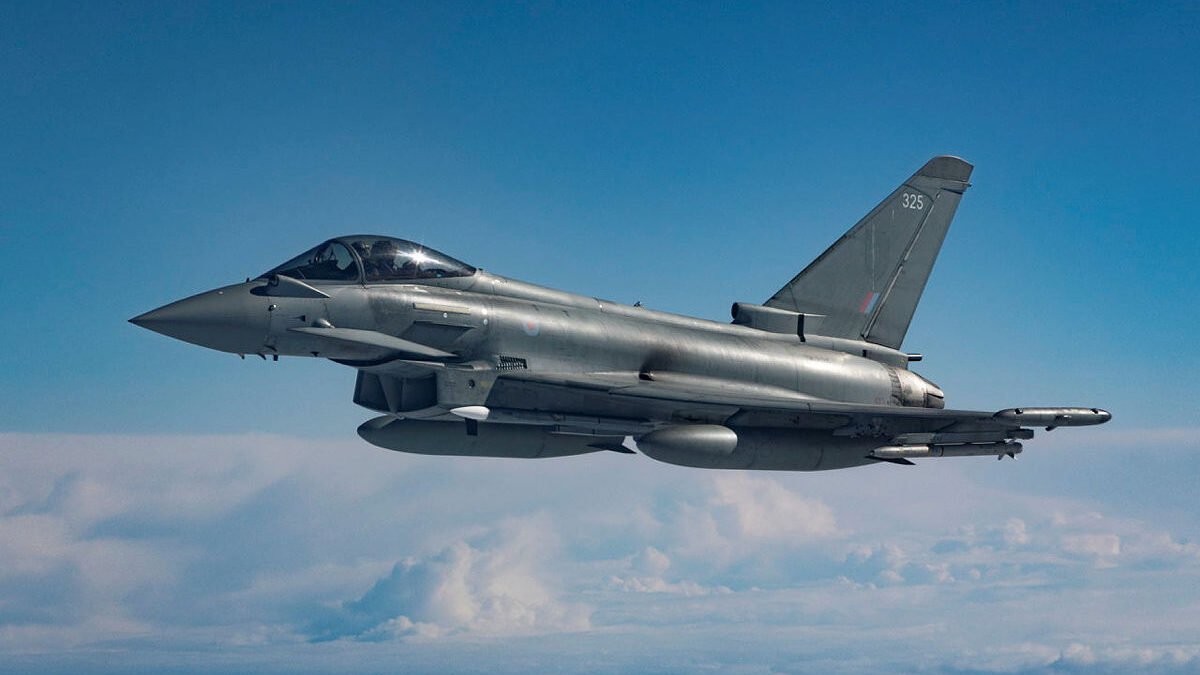
A UK Royal Air Force Eurofighter Typhoon takes flight during a NATO air policing mission (UK MoD)
BELFAST — The UK Ministry of Defence (MoD) is currently investigating the possibility of supplying Royal Air Force (RAF) Eurofighter Typhoon Tranche 1 fighter jets to European MiG-29 operators, so the Soviet-era aircraft can, in turn, be gifted to Ukraine.
Despite ruling out the direct supply of the Tranche 1 jets to Ukraine because of logistics difficulties, the potential handover of the aircraft to MiG-29 operators was acknowledged by UK armed forces minister James Heappey, during a British defense committee hearing last week.
He said the UK is “absolutely” looking into the matter, while a number of other countries are also “having this debate.”
Heappy did not provide specific details of how the plan would work, and the fact that the Tranche 1 fleet will be retired by the RAF in 2025 amounts to a significant maintenance drawback for any third-party operator considering taking up the UK’s offer.
Bulgaria, Poland and Slovakia all operate MiG-29 aircraft but have so far stopped short of giving any to Ukraine.
A political breakthrough on the issue appears to have emerged this month with Slovak defense minister Jaroslav Nad claiming he was told during a European Union meeting with Polish defense minister Mariusz Błaszczak that Warsaw will agree to a “joint process” allowing the two NATO countries to supply their respective MiG-29 fleets to Ukraine, according to Reuters. But it’s unclear where the Typhoon may come in, if at all.
Slovakia’s MiG-29 fleet is due to be replaced after an order with the US government for 14 Lockheed Martin F-16 Block 70 jets was signed in 2018. Delivery of a first aircraft is expected to take place next year. The Biden administration previously rejected Poland’s backfill request to receive “used aircraft with corresponding operational capabilities” so Polish MiG-29s could be sent to Ukraine.
Kyiv continues to request NATO fighter jets in a bid to counter Russia’s spring offensive, but even considering MiG-29s that would be more familiar to Ukrainian pilots, operational impact of additional supplies has drawn concern from defense analysts.
“It is worth remembering that more MiG-29s doesn’t really solve many of Ukraine’s problems, because they’re inherently still going to face the same limitations in terms of being completely outmatched by Russian aircraft in terms of range, reach of sensors and weapons,” said Justin Bronk, senior research fellow for airpower and technology at the UK-based Royal United Services Institute, defense think tank.
RELATED: In Ukraine fight, integrated air defense has made many aircraft ‘worthless,’ US general says
“Typhoons are also not going to provide any sort of solution to the very serious Russian ground-based air defense threat. Providing the MiG-29 is somewhat useful and can help replace losses of what they already had, but it really doesn’t change much beyond that,” he said.
For any countries hoping to give MiGs to get Typhoons, Bronk said, “In a year or two, the rundown of those assets [RAF Eurofighter Typhoon Tranche 1 jets] would commence anyway so the key issue would be around spares, the engineering and specialist contractor support that would be required to facilitate the British transfer.”
UK lawmakers said that the RAF currently operates a fleet of 30 Tranche 1 jets, 12 of which are in storage.
London has committed to training Ukrainian fighter jet pilots on its aircraft to support “post-war” military ambitions, not as a step toward the transfer of Western made combat jets.
“For a post-war reconstruction scenario, whatever is provided needs to be something Ukraine can afford to maintain and operate in reasonably significant numbers,” said Bronk. “It has a lot of airspace to patrol and given that the reason the UK is retiring Tranche 1 Typhoons because they are too expensive to maintain…and Ukraine has a crippled economy, devastated by the war, with hundreds of different priorities for reconstruction, it does seem a slightly strange aircraft to center around.”
Other drawbacks to the Typhoon backfill plan include MiG-29 operators potentially holding concerns over reducing “their own air defenses” by gifting the Russian-made jets to Ukraine, but then having to undertake pilot conversion courses and wait for months to fly the more modern aircraft. That’s a risky option, “given what’s going on in their neighborhood,” said Douglas Barrie, senior fellow for military aerospace at the UK-based International Institute for Strategic Studies military think tank.
Should the UK and MiG-29 operators reach an agreement, and Ukraine eventually receives additional fighter jets, there is little evidence to suggest a dramatic change in the outcome of the war will happen in the near term.
“A limited number of Western fighter jets supplied to Ukraine are not going to tip the balance on the ground, whatever models they are, because the ground based air defense strategy is just far too dense and layered,” said Bronk.
“There is no way to provide Ukraine with a sort of large-scale air power capability in the way that we think of Western air power,” he said. “It’s not just a few fast jets but a massive ecosystem, with all sorts of enablers, not just aircrew training but…everything from tankers through AWACS airborne battle management, planning software, how to run a massive air tasking order, all the weapons and electronic support measures that you need.”
Air Force awards SNC $13B contract for new ‘Doomsday’ plane
The win is a major victory for the firm in a competition that saw the surprise elimination of aerospace giant Boeing.


























